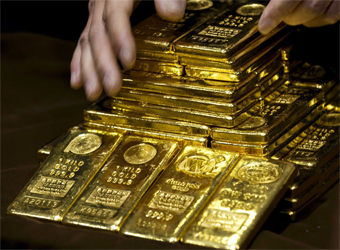Gold prices eased on Friday to stay on track for its first monthly loss this year, as hints from leading central banks that the era of easy money may be coming to a close pushed bond yields higher, hurting the non-interest bearing metal. While it is still up 8 percent in the first half, gold has stalled in the second quarter after a strong start to the year, and is little changed from where it ended March.
Spot gold was down 0.27 percent at $1,241.91 an ounce, while U.S. gold futures for August delivery settled down $3.5 lower at $1,242.30 an ounce .
Spot prices have fallen nearly two percent so far in June, and are down 0.4 percent in the second quarter. Comments from the euro zone, British and Canadian central banks this week indicated that quantitative easing programs in place since the financial crisis may be being wound up, leading to a gradual normalization of interest rates. That comes in the wake of the Federal Reserve’s decision to hike U.S. interest rates at its June meeting, and its indication that it will press ahead with plans to shrink its $4.5 trillion in bond holdings.
That comes in the wake of the Federal Reserve’s decision to hike U.S. interest rates at its June meeting, and its indication that it will press ahead with plans to shrink its $4.5 trillion in bond holdings.
“The most important thing for the gold market is that we have monetary policy tightening in the United States, and so with a further interest rate hike the gold price has gone down,” LBBW analyst Thorsten Proettel said. While the European Central Bank remains cautious on tightening monetary policy, the trend is turning more towards the hawkish side, he said. “From that perspective, it’s bad for gold.”
Germany’s benchmark ten -year bond yield was heading for its biggest weekly jump since late 2015, topping a week in which yields across the euro zone have soared as investors brace for an end to the era of ultra-easy monetary policy. On the other side of the Atlantic, U.S. Treasury yields rose for a fourth straight day as inflation data was not seen as weak enough to delay the Fed’s expected path on interest rate hikes.
Rising yields helped offset the positive impact of a weaker dollar on gold. The U.S. currency was on course for its worst quarter in seven years. “The U.S. dollar has softened, though this does not appear to have had the positive effect on price as we might have hoped,” MKS said in a note.
Among other precious metals, silver was up 0.24 percent at $16.63 an ounce. Silver has seen the biggest fall among major precious metals this quarter, down nearly 9 percent, while palladium is the best performer, up 6.1 percent.
Palladium was down 0.54 percent at $842.90 an ounce on Friday, while platinum was down 0.13 percent at $918.85.
Source: Reuters



